Of course! It has been proven that babies who get introduced to food on BLW are less likely to reject new foods. Mealtimes become a stimulating experience that lets them find a wider variety of foods to enjoy.
Ultimate Guide to Baby Led Weaning (and Best First Foods)
By: Dr. Maria Cerino - Updated April 7, 2024 - 12 Minute Read
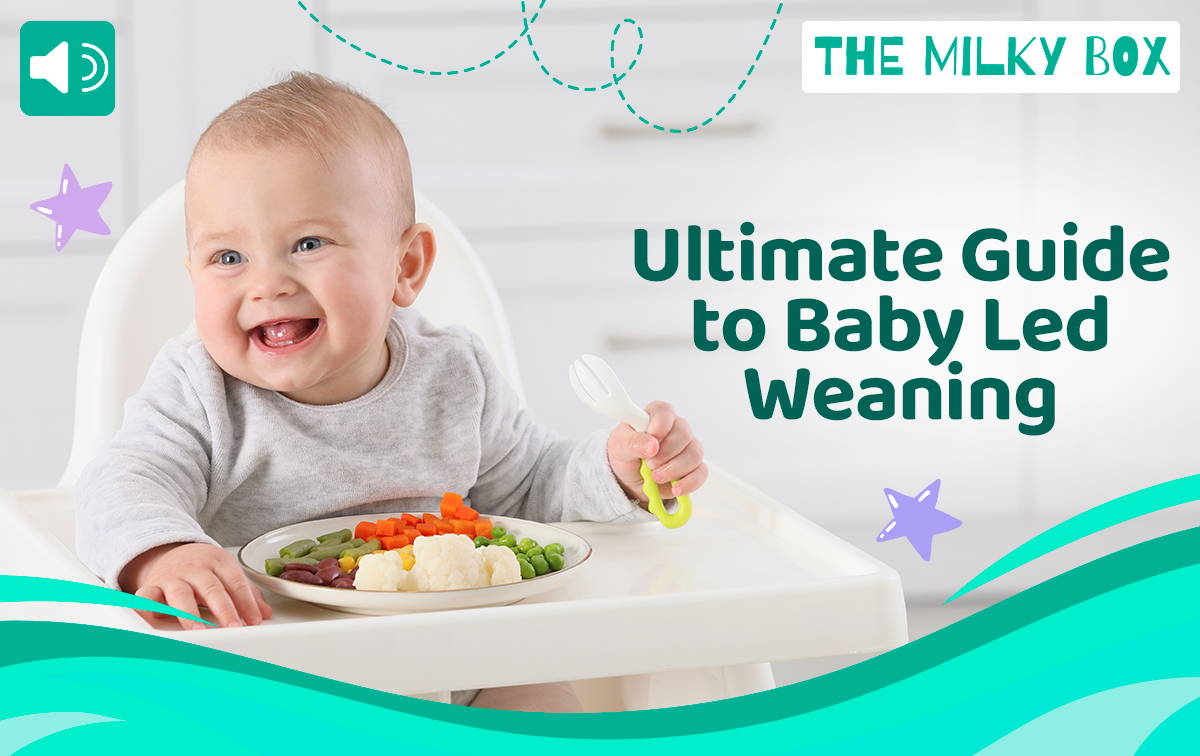
What exactly is baby-led weaning, and why is it all over my social media news feed? In this article, we’ll give you the most complete information on baby-led weaning (BLW) so you can get started too. We covered the absolute best organic formulas recently, but what about solids?
How do we start, and when does it end? Experts were initially hesitant, but now embrace baby-led weaning for its benefits for babies.
Table of Contents:
1. How to Start Baby Led Weaning (BLW)
2. When is Baby Ready for BLW?
3. But… where did Baby Lead Weaning come from?
4. Involvement During Family Meal Time
5. Sample Baby-Led Weaning Feeding Schedule
6. What age should I start baby led weaning?
7. Best First Foods for Baby Led Weaning
8. Offer food without pressure
9. Avoid foods that pose a choking hazard
10. How Do I Know My Baby is Ready to Start Solid Food?
11. Porridge for Baby-Led Weaning
12. Do Babies Need Teeth for Baby Led Weaning?
14. In conclusion…
15. Frequently Asked Questions
How to Start Baby Led Weaning (BLW)
Baby-led Weaning is a relatively new term used to describe a healthier, more enriching form of nutrition for your baby. It consists of skipping the puree phase and letting them explore foods from early on.
When is Baby Ready for BLW?
Baby-led weaning focuses on allowing babies 6 months or older to start self-feeding via safe solid foods. It’s never meant to be an aggressive introduction of solids for them.
Contrary to widespread belief, baby-led weaning is a progressive, slow way of introducing them to natural foods that they will eventually fall in love with.
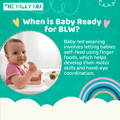
But… where did Baby Lead Weaning come from?
As a concept, baby-led weaning is relatively new. It was first introduced in 2001, by Gill Rapley, who dedicated 35 years of her life working with babies of different ages and stages of development.
Throughout her career as a general nurse, health visitor, midwife, breastfeeding counselor, and lactation consultant, she noticed the most common issues with the introduction of solid foods and the difficulties mothers faced during this period. Nevertheless, it is widely known that parents have been allowing their babies to explore and get familiar with different types of food for decades.
The movement is getting increasingly popular in the UK and New Zealand, and we’re here to give you a complete guide so you can make the best decision for your own needs.
Involvement During Family Meal Time
The second most important feature of baby-led weaning is that it allows infants to integrate into family mealtimes. They stop being bystanders in these crucial moments of their lives and become part of the activity.
The baby is offered baby-fist-size pieces of soft, easy-to-chew food from the very start of their complementary feeding, at around six months of age.
Please remember it is necessary to wait for them to reach this age before trying to introduce new foods.
Increases Favorable Feeding Practices
Baby-led Weaning promotes, more than anything, independence. Through the promotion of active participation in a fundamental activity such as eating, we allow our babies to develop their criteria from the start.
Baby Led Weaning and Choking
Some of the more traditionally inclined parents’ greatest concerns involve choking hazards. It is very important to observe the child’s development stage when Baby-led Weaning begins. To put it plainly - some babies are late bloomers, and that’s okay.
First Foods for Baby
It’s important to follow pediatric guidelines according to the baby’s age and to introduce foods slowly. You can start by giving them one new fruit or vegetable every two weeks, giving them enough time to get familiar with the flavors and textures.
Sample Baby-Led Weaning Feeding Schedule
Babies can eat a wide variety of foods through baby-led weaning (BLW), starting from around 6 months of age.
The right size and balance can provide your little one with nutrients to support their rapid growth and development.
● From 6-8 months of age: It’s ideal to introduce solids two or three times a day, plus their daily servings of Organic formula.
● From 9 months onwards: Solids can be consumed 3-4 times a day until they’re weaned off toddler milk.
Appropriate shapes, textures and sizes at every age
Heavy seasoning must be avoided in babies. It’s safer to stick with a pinch of salt.
You can also offer water with every solid meal but remember that they only require between half a cup to a cup a day, so small sips are the safest way to go.
A baby-led weaning meal should be colorful. It should include veggies, fruits, and protein. For example, you could include a piece of soft broccoli, a matchstick-sized avocado toast, and a small piece of chicken.

What age should I start baby led weaning?
Baby Led Weaning should be started on babies six months or older. You can even switch from a traditional feeding scheme to baby-led weaning if you feel like it’s the best option for you.
The facts are that from six months onwards, breastfeeding does not provide the infant with enough vitamins to fill out their requirements.
Babies grow fast, and around that age, they need all the help they can get from complementary foods.
As always, keeping track of their weight and height at control appointments is the best way we can get reassurance that we’re doing things well, or we can get feedback and improve on aspects that are trickier to get right. It’s all about learning.
Start with Soft Foods
All foods must be cooked first. It must be soft, and easy to mush between your fingers. We strongly suggest trying a piece before serving just to be safe.
Best First Foods for Baby Led Weaning
If you’re anything like us, you’re always in the search for the best option. Keeping the freshness and natural qualities of foods is key here, as this is your baby’s first introduction to them. Here are the tried & true foods to begin your Baby Led Weaning journey.
● Fruits and veggies - Essential for complimentary vitamins: Cooked carrot, sweet potato, squash, broccoli, cauliflower, zuccini. For fruits, they can enjoy most of them as long as they are ripe enough and the seeds have been taken care of: peaches, banana sticks, kiwi, oranges, strawberries, watermelon, blueberries, raspberries, pitted cherries, and cooked apples.
● Healthy Fats: Avocado, eggs, nut butter (if allergies are absent), real butter, salmon, olive oil, yogurt on a spoon, hummus, and small quantities of goat cheese.
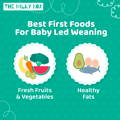
Offer food without pressure
The idea is to allow them to nibble at them at their own pace while giving them enough surface to hold it on their own.
It has been proven that this is very good for their motor skills. Just be prepared for a messy table. It happens! But allowing them to enjoy food from a different perspective is worth it.
Can you serve baby the same foods as the rest of the family when doing baby-led weaning?
Yes! It’s one of the many ways why it’s so easy to make them feel part of the family. They get to see you enjoy the same foods on their plate.
You will need to make some modifications like chopping up meats and veggies to appropriate size and holding off the spicy sauces, but your options will be endless. Variety will become your best friend.
Continue giving your baby milk – how much milk should my baby be drinking
Babies should be still consuming more than half of their calories and nutrients from milk. They’ll still need about 24-36 ounces depending on their age. Once they reach their first year, it can go down to 16-30 oz daily.
Please remember to consult pediatric guidelines for a more accurate feeding based on their weight and age.
Avoid foods that pose a choking hazard
You can start with softer foods, more supervision and avoid all foods that are known choking hazards, such as peanuts and full grapes.
So far, no increased risks have been found in clinical research studies that compare traditional feeding versus Baby Led Weaning.
How To Cut Foods for BLW
The size can stay pretty homogenous between foods. You’ll need to cut up all foods into matchsticks like pieces about the size of an adult pinky.
How Do I Know My Baby is Ready to Start Solid Food?
Before getting to choosing the right foods, we need some basics to set the scene.
● A high chair to ensure correct alignment of the baby’s chest and stomach.
● A baby who is old enough and starts showing interest in foods.
● A divided plate to help keep variety in rotation and make all options look interesting. Suction is a great addition too - helps keep things nice and tidy.
● A parent willing to supervise the entire feeding process. This will help you stay calm while strengthening the bond between you and your baby.
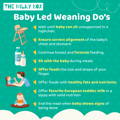
Remember to Make Iron-Rich Foods the Priority When Starting Solids
One of the trickiest nutrients is iron. Found mainly in harder-to-chew foods such as meat, their introduction needs to be slower. But there’s no need to worry about it.
Pediatricians suggest the addition of iron-enriched cereals made for infants into their diet to ensure proper iron consumption.
Iron-rich foods are great for neurological development and help avoid anemia and other nutritional deficiencies that could impair their growth. You can find iron in meat, poultry, lentils, and beans.
Porridge for Baby-Led Weaning
Porridge is a delicious and nutritious food that can be a perfect addition to your baby's diet during the weaning process. It is an excellent source of protein and slow-release energy, making it an ideal food for your baby's developing body and brain.
One of the great things about porridge is that you can easily modify the recipe to create a variety of flavors that your baby will love. You can provide your little one with various tastes and textures to explore and enjoy, whether you add fruit or spices.
With porridge, you can start your baby on a healthy and tasty journey to a lifetime of good eating habits.
Organic Baby Porridge
Holle organic oatmeal baby porridge is a wholesome and nutritious option for babies who are beginning to wean and are four months old or older. This porridge uses easily digestible whole grains, making it gentle on the baby's delicate stomach.
The grains used in Holle porridges are carefully selected and are gently unlocked with heat and moisture, which helps to retain the nutrients. This means the porridge provides a valuable foundation for a full-fledged diet, especially for infants and small children.
Holle porridges are made using organic ingredients, ensuring your baby is not exposed to harmful chemicals. The porridge is free from added sugars, salt, or additives, making it a natural and healthy choice.
Additionally, Holle porridges offer different variations on preparations for various diets, making it easier for parents to choose the right porridge that suits their baby's needs.
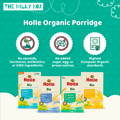
Do Babies Need Teeth for Baby Led Weaning?
Babies should be able to consume soft foods without the help of teeth at the very beginning. It's necessary to boil foods until it’s easy to smush them with your fingertips, without using a lot of strength. That’s how you’ll know.
Signs of gagging include
While introducing BLW, you’ll need to be present, looking out for any signs of choking. Signs of gagging include sudden teary eyes, inability to cry, pushing their tongue forward and pushing food to the front of their mouth.
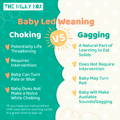
Palmar and Pincer Grasp
A certain level of fine motor skills are necessary to ensure your baby can take on a solid diet. The Palmar grasp should be developed by 6 months old. Your baby should be using the central portion of the palm to pick up objects from a flat surface.
The pincer grasp develops later, between 9 to 12 months. Your child should be picking up small objects with the tips of thumb and index finger, while holding forearm off of surface.
In conclusion…
The beauty of Baby Led Weaning lies in its intuitive nature. As parents, we’d like to ensure our babies are capable of digesting their next meal appropriately.
If you like to go down the safe route and follow evidence supported by the medical community, we have good news. Energy and vitamin levels are not different between babies who grow on traditional, puree-based feeding and BLW. You can be sure they will receive the nutrition they require while getting many more amazing benefits in the long run.
However, it is important to remember that milk consumption is still a crucial part of their day-to-day life. The quality of their formula makes a world’s difference when it comes to nutrition. This is what we do, this is what The Milky Box is passionate about: providing you with the absolute best options in organic, clean formulas so you can make the best choice possible for your little ones.
Frequently Asked Questions
Will Baby Led Weaning help me avoid picky eaters?
Is screen time okay during BLW?
The short answer is no. Letting your baby get distracted with media during their feeding times will lessen the enrichment qualities of the experience, as babies tend to draw their attention to the screens immediately. We suggest using these times as moments of close contact between parents and baby.
Research indicates that children who spend more than 45 minutes daily using technology experience adverse effects on brain development and socialization. Therefore, limiting and avoiding using technology during meal times is advisable.
What foods could I get my baby started on first?
If you’re struggling to decide what should be your baby’s first solid food, don’t worry! It’s a very intimidating decision and we’ve certainly been there before. Start simple. You can start by combining two or more foods, for example: boiled carrot matchsticks and a tablespoon of organic yogurt. It doesn’t have to be anything too complicated.
Should I continue giving my baby formula after they begin eating solids?
Absolutely. When babies are just getting started with solids, they mostly nibble and pick at their food, this is normal behavior. However, we need to meet the caloric requirements every single day, so a nutritious, organic formula will be needed to accompany them on this journey.
Disclaimer:
Please be aware that this information is based on general trends in babies, and it is not medical advice. Your doctor should be your first source of information and advice when considering any changes to your child’s formula and when choosing your child’s formula. Always consult your pediatrician before making any decisions about your child’s diet or if you notice any changes in your child.
Breastfeeding is the best nutrition for your baby because breast milk provides your child with all the essential nutrients they need for growth and development. Please consult your pediatrician if your child requires supplemental feeding.

Dr. Maria Cerino is a medical doctor and a researcher from Mexico, her works being published in prestigious journals like the American Journal of Human Biology among others. As a medical writer, Dr. Cerino focuses on infant nutrition and healthy neurological development in infants and children. In her free time, she enjoys going on walks, watching indie films, and cooking at home.
Read Next:
Reviewed by Dr. Eric Wood, ND, MA

Dr. Wood is a licensed naturopathic doctor, with a doctorate degree from the Canadian College of Naturopathic Medicine in Toronto, Canada. He received his post-graduation certification in Mind Body Medicine at Harvard University.
With 15 years of experience, Dr. Wood is an Associate Professor of Holistic Nutrition at the American College of Health Sciences in Portland, Oregon. Dr. Wood is an educator, clinician, author, media figure, consultant, and owns his own holistic (naturopathic) medical practice in Ft. Lauderdale, Florida. Dr. Wood is currently researching and drafting books on cancer and pediatrics.
Outside of the medical profession, Dr. Wood loves singing with the Miami Lyric Opera and is an avid musician in South Florida. He also loves spending time with his wife and kids.

